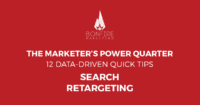Historically, brands and businesses interested in examining search engine optimization were only interested in one thing: getting the top ranking of their vertical’s most coveted keywords. Businesses often task agencies or their internal marketing team with optimizing their website, producing content, and acquiring backlinks for this sole purpose — all at a considerable cost to achieve that glorious keyword ranking.
But once you achieve that sweet spot, then what? This post will explore the best ways to measure revenue goals, identify KPIs, and maximize ROI on SEO.
The value of SEO
What is the value of your keyword ranking, and how can you determine that value to demonstrate a return on investment for the next round of department budgets? Rankings are just the start in measuring SEO success; the money generated from traffic these keywords bring is the end goal.
ROI is measured for SEO the same way it is for anything else: (Revenue – Cost) / Cost.
What makes SEO ROI more difficult to measure is the patience it requires before the big break. You’re likely spending a lot of money up front to acquire a foothold in your niche’s search results. Organic traffic will not spike overnight after completing a full SEO audit and rebuild.
Say you’ve been plugging away at updating your site, optimizing your content, and developing all new backlinks. If you’ve just started a new SEO campaign or are doing SEO for the first time, don’t expect to see a total return for all those man-hours in one week. Because SEO is a long game (unlike AdWords and paid social), ROI should be measured in larger time intervals — over several months or even a full quarter.
The best ROI measurements at the start of the campaign may not be monetary, but instead appear as month-over-month traffic growth to ensure your campaign is progressing effectively.
Other common ways marketers measure returns on spend for campaigns include engagement metrics for organic traffic: time on site, pageviews per visit, bounce rates, etc. While these metrics are certainly viable performance indicators, eventually you will need to start measuring dollars and cents.
While it’s pretty cut-and-dry for e-commerce sites to measure SEO ROI — measuring the number of transactions and revenue coming from organic traffic — sites that do not operate e-commerce have more work to do.
There are many reasons a brand may want to increase visibility in search engines, like awareness, thought leadership, etc. But by and large, most sites exist to gather sales leads. Common methods for setting goals for lead acquisition include:
- Contact form submissions.
- Email registration or subscriptions.
- Webinars.
- Demo sign-ups.
- Account sign-ups.
If you haven’t already, set goal tracking in Google Analytics for all forms used on your site to collect lead information.

How to start measuring SEO ROI
To begin measuring ROI, establish your monthly costs and initial organic traffic benchmarks. Calculate how much you spend per month on SEO. This could be your monthly fee to your agency or how many hours internally your marketing department worked on building content, optimizing the site, and conducting keyword, vertical, and competitor research.
Set a benchmark with how many unique organic visitors your site is already getting. Identify the conversion rate of users filling out the forms, and the revenue you get per conversion.
Then determine the ratio of leads that convert to sales. If you don’t already know, consult with your sales team to determine what ratio of online leads convert, and what is the average of each conversion.
Once you’ve established this data with your sales team, you can figure out how many conversions are needed per month to achieve a successful ROI. Say, for example, you want 2.5 times the return on SEO per month and the following are true:
- You spend $5,000 per month on content development and backlink acquisition.
- 10 percent of your organic traffic leads convert into paying customers.
- Each paying customer brings in $500.
You will need to acquire 250 lead form fills to convert enough to get the targeted ROI of $12,500, and 25 of those leads need to convert. If you have a lead form completion rate of three percent, you’ll need to earn about 8,500 unique visitors per month to obtain your revenue number.
When SEO ranking can make a difference
For small to medium businesses, today’s modern SEO is all about targeting a variety of long-tail keywords with lower search volume rather than a few key head terms that have a ton of search volume but are difficult to rank prominently. Therefore, it is critical to focus a wide variety of long-tail keywords that bring in a more targeted audience ready to convert.
This is where rankings finally become most important. It is much better to rank number one for a wide range of long-tail keywords than to rank at the bottom of the first page for larger search volume keywords.
The typical click-through rate for the top spot is 35 percent, so you’ll need to rank for enough keywords to collectively earn at least 25,000 average monthly searches. Of course, you’re probably not going to rank first for all of your long-tail keywords, so consider that you will need even more search impressions than that — upwards of 50,000–100,000 impressions.
But how do you know which keywords are driving the best conversion traffic? This is a little more difficult. Unfortunately, Google encrypts a significant amount of organic keyword data. And the search query data available via Google search console is limited only to clicks, rank, and impressions. So that leaves a little bit of guesswork.
For the most part, traffic to your homepage will come from branded searches. These are users already familiar with your brand, products, and services. This data, in large part, should not be considered in your ROI. While most keyword data is encrypted, you can monitor the progress of your rankings by using scraper tools like SEMRush, or by looking in your Google Analytics account to see the growth in organic traffic landing on internal landing pages. These pages are the ones with content optimized for your keywords, so the more traffic they get, the more your SEO content development strategy is working.

When done right, SEO is very lucrative for all types of business. Just be sure you’re measuring proper ROI to determine whether your current strategy is effective for your business needs.
Related resources:
More Content
The Marketer’s Power Quarter: Boost Social Promotion
This is the ninth in a 12-part series of quick-fix tips to improve your digital marketing results. Catch up on our last tip, and subscribe to our newsletter to get
The Marketer’s Power Quarter: A Local SEO Strategy
This is the sixth in a 12-part series of quick-fix tips to improve your digital marketing results. Catch up on our last tip, and subscribe to our newsletter to get
The Marketer’s Power Quarter: Better Ad Retargeting
This is the fifth in a 12-part series of quick-fix tips to improve your digital marketing results. Catch up on our last tip, and subscribe to our newsletter to get the





Leave A Comment